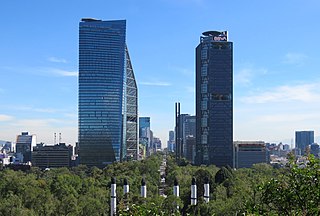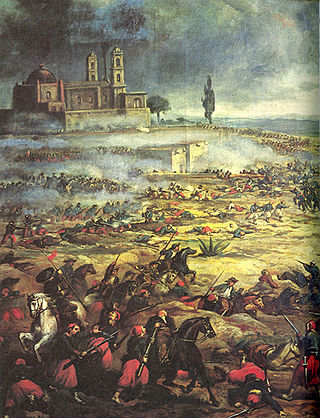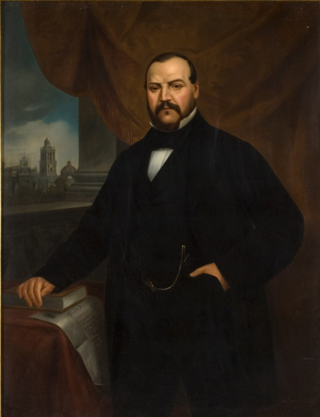
Puebla de Zaragoza, formally Heroica Puebla de Zaragoza, formerly Puebla de los Ángeles during colonial times, or known simply as Puebla, is the seat of Puebla Municipality. It is the capital and largest city of the state of Puebla, and the fourth largest city in Mexico, after Mexico City, Monterrey, and Guadalajara. A viceregal era planned city, it is located in the southern part of Central Mexico on the main route between Mexico City and Mexico's main Atlantic port, Veracruz—about 100 km (62 mi) east southeast of Mexico City and about 220 km (140 mi) west of Veracruz.

Paseo de la Reforma is a wide avenue that runs diagonally across the heart of Mexico City. It was designed at the behest of Emperor Maximilian by Ferdinand von Rosenzweig during the era of the Second Mexican Empire and modeled after the great boulevards of Europe, such as the Ringstraße in Vienna and the Champs-Élysées in Paris. The planned grand avenue was to link the National Palace with the imperial residence, Chapultepec Castle, which was then on the southwestern edge of town. The project was originally named Paseo de la Emperatriz in honor of Maximilian's consort Empress Carlota. After the fall of the Empire and Maximilian's subsequent execution, the Restored Republic renamed the Paseo in honor of the La Reforma.

San Pedro Sula is the capital of Cortés Department, Honduras. It is located in the northwest corner of the country in the Sula Valley, about 50 kilometers south of Puerto Cortés on the Caribbean Sea. With a population of 701,200 in the central urban area and a population of 1,445,598 in its metropolitan area in 2023, it is the nation's primary industrial center and second largest city after the capital Tegucigalpa, and the largest city in Central America that is not a capital city.

The Battle of Puebla took place on 5 May, Cinco de Mayo, 1862, near Puebla de los Ángeles, during the Second French intervention in Mexico. French troops under the command of Charles de Lorencez repeatedly failed to storm the forts of Loreto and Guadalupe situated on top of the hills overlooking the city of Puebla, and eventually retreated to Orizaba in order to await reinforcements. Lorencez was dismissed from his command, and French troops under Élie Frédéric Forey would eventually take the city, but the Mexican victory at Puebla against a better equipped force provided patriotic inspiration to the Mexicans.

Benito Juárez, is a borough in Mexico City. It is a largely residential area, located to the south of historic center of Mexico City, although there are pressures for areas to convert to commercial use. It was named after Benito Juárez, president in the 19th century.

Ignacio Gregorio Comonfort de los Ríos, known as Ignacio Comonfort, was a Mexican politician and soldier who was also president during La Reforma.
Huitzilac is a city in the Mexican state of Morelos. It stands at 19°01′42″N99°16′02″W and at an altitude of 2,561 m (8,402 ft) above sea level.

The Niños Héroes were six Mexican military cadets who were killed in the defence of Mexico City during the Battle of Chapultepec, one of the last major battles of the Mexican–American War, on 13 September 1847. The date of the battle is now celebrated in Mexico as a civic holiday to honor the cadets' sacrifice.

San Juan del Río is a city and administration of the surrounding San Juan del Río Municipality in the central Mexican state of Querétaro. The population in for the municipality is 268,408 as of 2015.

Colonia Roma, also called La Roma or simply, Roma, is a district located in the Cuauhtémoc borough of Mexico City just west of the city's historic center, and in fact is no longer a single colonia (neighbourhood) but now two officially defined ones, Roma Norte and Roma Sur, divided by Coahuila street.

The Basilica Cathedral of Puebla, as the Cathedral of Our Lady of the Immaculate Conception is known according to its Marian invocation, is the episcopal see of the Archdiocese of Puebla de los Ángeles (Mexico). It is one of the most important buildings in the historic center of Puebla declared a World Heritage Site by UNESCO. It has the prerogative of being the first sumptuous temple that under good designs was made in the Americas, consecrated in 1649, ahead of the Metropolitan of Mexico that was dedicated in 1653. It was founded by Philip II of Spain.
Juan de Salmerón was a Spanish colonial official New Spain, and an oidor (judge) of the second Real Audiencia of Mexico, which governed the colony from January 10, 1531 until April 16, 1534. On the latter date, the government was turned over to Antonio de Mendoza, the first Viceroy of New Spain. Along with Fray Toribio de Benavente Motolinia he built the first European settlement at Puebla, Puebla.

Colonia Tabacalera is a colonia or neighborhood in the Cuauhtémoc borough of Mexico City, on the western border of the city's historic center. It was created in the late 19th century along with other nearby colonias such as Colonia San Rafael and Colonia Santa María la Ribera. From the early 1900s, it became a mixture of mansions and apartment buildings, with major constructions such as the now Monument to the Revolution and the El Moro skyscraper built in the first half of the century. By the 1950s, the area had a bohemian reputation with writers, artists, and exiles living there. These included Fidel Castro and Ernesto “Che” Guevara, who met each other and began planning the Cuban Revolution there. Today, the colonia is in decline with problems such as prostitution, crime, street vending and traffic. However, the area is still home to some of the many traditional Mexican cantinas that populated it in its heyday.
Ernesto Tamariz Galicia was a 20th-century Mexican sculptor specialized in public monuments, religious statues and funerary art.

The Monument to Cuauhtémoc is an 1887 monument dedicated to the last Mexica ruler (tlatoani) of Tenochtitlan Cuauhtémoc, located at the intersection of Avenida de los Insurgentes and Paseo de la Reforma in Mexico City. It is the work of Francisco Jiménez and Miguel Noreña in the "neoindigenismo", and was proposed to promote the new government of Porfirio Díaz.
Federal Highway 150D is a toll highway connecting Mexico City to Veracruz City via Puebla City and Córdoba. It serves as one of the backbones of Mexico's toll road system. The road is primarily operated by Caminos y Puentes Federales, which charges cars 520 pesos to travel Highway 150D, with one segment in the Puebla metropolitan area built and maintained by OHL and PINFRA.

The Monumento a los Niños Héroes, officially Altar a la Patria, is a monument installed in the park of Chapultepec in Mexico City, Mexico. It commemorates the Niños Héroes, six mostly teenage military cadets who were killed defending Mexico City from the United States during the Battle of Chapultepec, one of the last major battles of the Mexican–American War, on 13 September 1847.
Plaza Universidad is a shopping mall located on Avenida Universidad in colonia Santa Cruz Atoyac, Benito Juárez borough, Mexico City. It was the first shopping center anchored by a department store built in the city, opened on November 28, 1969. It is still anchored by Sears Mexico, as well as Sanborn's, Yak Casino, and Cinépolis multicinemas.

The Fuente de la República is a carbon steel fountain and sculpture installed in Mexico City, Mexico. It was inaugurated on 13 December 2007 by Marcelo Ebrard, the Federal District's head of government, and was placed at the intersection of Avenida Paseo de la Reforma, Avenida Juárez and Avenida Bucareli, in the Cuauhtémoc borough. The fountain was created specifically for the celebrations of the 200th anniversary of the country's independence in 2010. It was designed by Manuel Felguérez, who also designed the Puerta 1808 sculpture found in front of it.















